Marking its 15th anniversary, the Texas Advanced Computing Center (TACC) at the University of Texas at Austin announced the dedication of a new building at the JJ Pickle Research Campus, and a $30 million award from the National Science Foundation.

Pictured, the first Stampede
In 2001 Dr. Jay Boisseau was hired to build an advanced computing center at the University of Texas. Dr. Boisseau names the new center the Texas Advanced Computing Center (TACC) and lays out its mission of enabling discoveries that advance science and society through the application of advanced computing technologies. Since then TACC has built and deployed several supercomputers with the latest announced being Stampede 2. Since its creation TACC has made several research breakthroughs in fields such as biomedical, Gravity Recovery and Climate Experiment, black holes, history of the universe, viral mutations, wildlife conservation, plate tectonics, hurricane predictions, and Alzheimer’s research.
With the grant, the TACC intends to deploy a Dell PowerEdge cluster: Stampede 2. This supercomputing system was designed with the purpose of offering high-performance computing capability for researchers across the US, and is the largest cluster in the Extreme Science and Engineering Discovery Environment (XSEDE).
The new Stampede 2 system delivers a peak performance of up to 18 petaflops, and will deploy new processors in phases, including the latest Intel Xeon Phi chips. Currently, the Stampede 2’s predecessor is among the top 10 most powerful supercomputers in the world, soon to be overtaken by the new hardware.




 Amazon
Amazon